Metal Braided Hose with Flexible Material
- Loading Port:
- Tianjin
- Payment Terms:
- TT OR LC
- Min Order Qty:
- 1000 pc
- Supply Capability:
- 100000 pc/month
OKorder Service Pledge
OKorder Financial Service
You Might Also Like
Item specifice
Metal Braided Hose with Flexible Material
Applications of Metal Braided Hose with Flexible Material:
--Refueling system
--Chemical and pharmaceutical industry
--Industrial hydraulic systems
--Air conditioners in industrial and construction –site vehicles
--Food and beverage industry
--Special and standard industrial applications
--Water and cleaning management
Features of Metal Braided Hose with Flexible Material:
1. )O. D.: 13-18MM 0.2-3M long
2. )Nut.: Nickel/Chrome Plated Brass (Zinc / Iron / Aluminum is available)
3. )Size Of Nut.: Female&Male 1/2''; 3/4''; 3/8''; 7/8''; 5/16'', and M10...
4. )Insert.: Brass (Zinc / Aluminum / Plastic is available)
5. )Inner tube.: Rubber/ EPDM/PVC
6. )Covered Material: Stainless Steel 201, 301, 304 /Aluminium Wire
7. )Working Pressure: 5Kg-15Kg
8. )Temperature: 0-92° C
9. )Quality Assurance: 3 years
RemarkAPPLICATION: HOUSEEHOLD WARE, BATHROOM WARE, SHOWER HOSE
PAYMENT: T/T, L/C
DELIVERY TIME: 20DAYS OR 30DAYS AFTER RECEIVED 30% DEPOSITS
MOQ: 5000PCS
ODM&OEM IS ACCEPTABLE
PackageInner: PP bag /Blister packing Outer: Carton box
Specifications of Metal Braided Hose with Flexible Material:
NO | I.D | Refer to O.D | Working pressure | Burst pressure | approximate Weight | |||||
(inch) | (mm) | (inch) | (mm) | MPa | Psi | MPa | Psi | kg/m | lbs/ft | |
1 | 1/8 | 3.2±0.2 | 0.35 | 9±0.3 | 2.06 | 300 | 8.27 | 1200 | 0.078 | 0.12 |
2 | 5/32 | 4±0.2 | 0.4 | 10±0.3 | 2.06 | 300 | 8.27 | 1200 | 0.092 | 0.14 |
3 | 3/16 | 4.8±0.2 | 0.43 | 11±0.3 | 2.06 | 300 | 8.27 | 1200 | 0.108 | 0.16 |
4 | 1/4 | 6.3±0.3 | 0.5 | 12.7±0.3 | 2.06 | 300 | 8.27 | 1200 | 0.134 | 0.2 |
5 | 5/16 | 8.0±0.3 | 0.56 | 14±0.3 | 2.06 | 300 | 8.27 | 1200 | 0.147 | 0.22 |
6 | 3/8 | 9.5±0.3 | 0.63 | 16±0.4 | 2.06 | 300 | 8.27 | 1200 | 0.182 | 0.27 |
7 | 15/32 | 12±0.3 | 0.75 | 19±0.5 | 2.06 | 300 | 8.27 | 1200 | 0.238 | 0.35 |
8 | 1/2 | 12.7±0.4 | 0.78 | 20±0.5 | 2.06 | 300 | 8.27 | 1200 | 0.262 | 0.39 |
9 | 5/8 | 16±0.4 | 0.94 | 24±0.5 | 1.03 | 150 | 4.12 | 600 | 0.351 | 0.52 |
10 | 3/4 | 19±0.4 | 1.13 | 28.8±0.5 | 1.03 | 150 | 4.12 | 600 | 0.515 | 0.77 |
11 | 1 | 25.4±0.5 | 1.38 | 35±0.6 | 1.03 | 150 | 4.12 | 600 | 0.637 | 0.95 |
Images of Metal Braided Hose with Flexible Material:
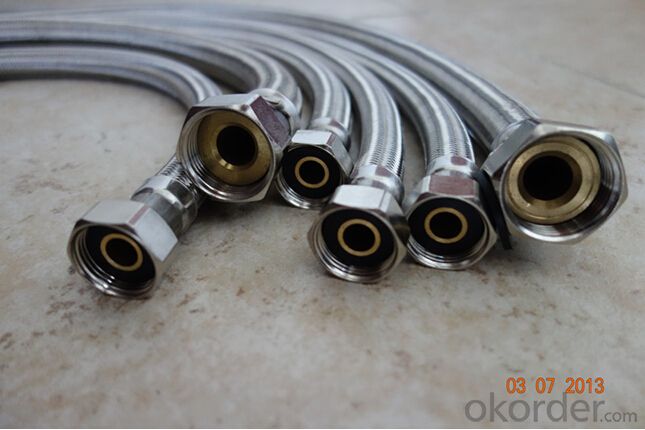
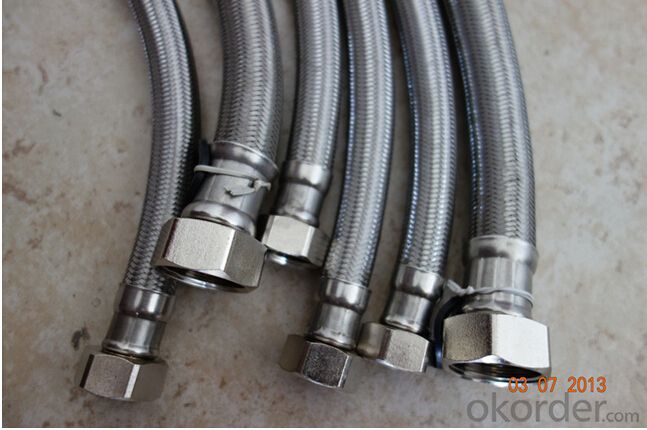
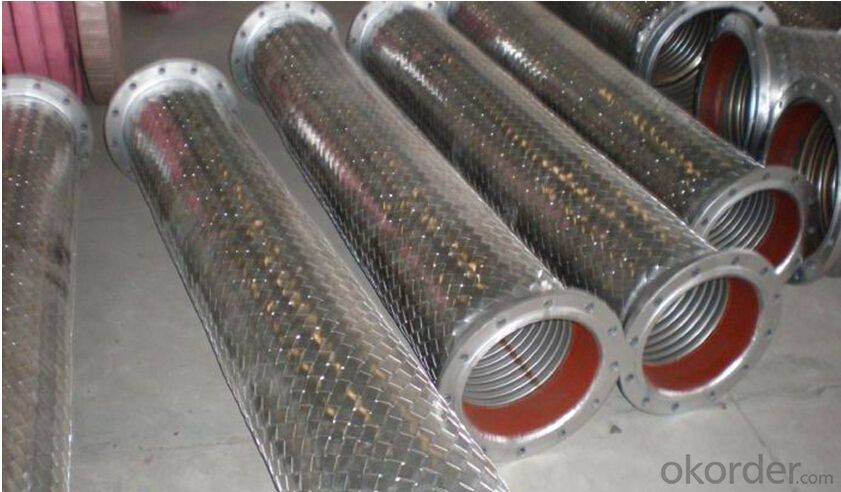
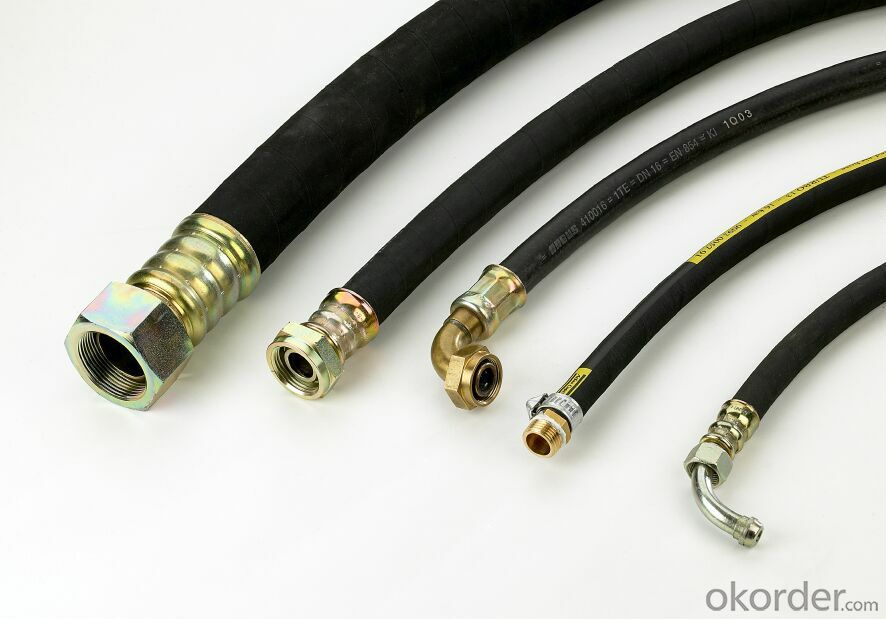
Package of Metal Braided Hose with Flexible Material:
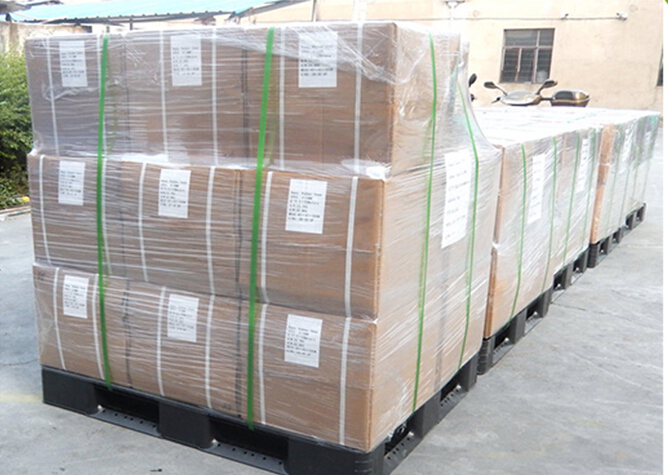
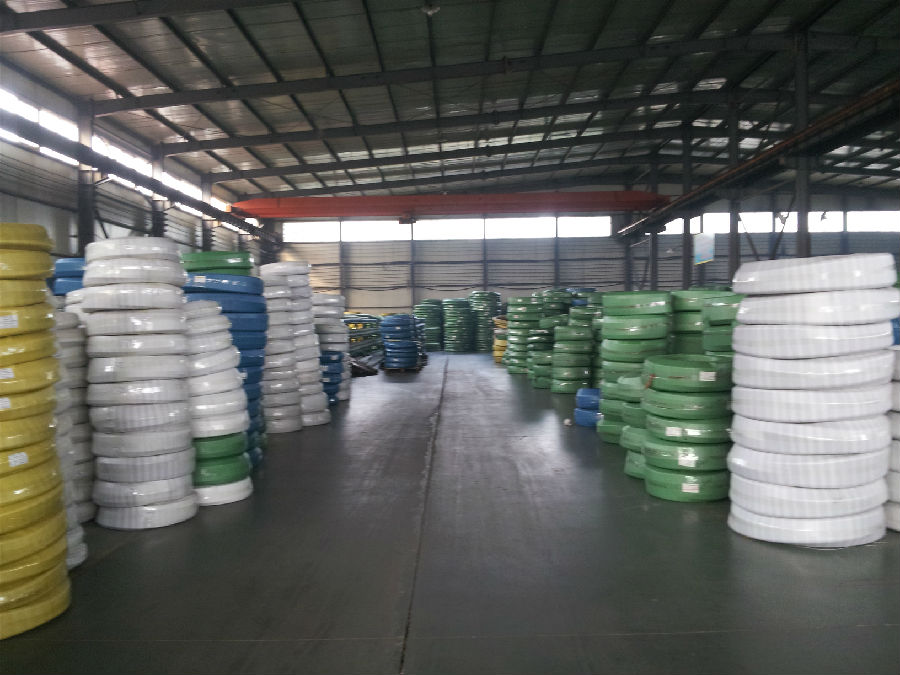
FAQ of Metal Braided Hose with Flexible Material:
Who we are:
Answer: We CNBM is a Chinese state-owned enterprise ranked 267th among the Global Fortune 500, as the largest building materials company,we have over 300 affiliated companies,and so many production lines and branch office distribute in China.
2. About our quality:
Answer: Every product needs to be quality proved before shipping.
3. About our service:
Answer: We could gurantte that we can reply you in 2 working hours.
- Q:Can stainless steel pipes be insulated with silicone?
- Yes, stainless steel pipes can be insulated with silicone. Silicone insulation is commonly used for its high temperature resistance and excellent thermal conductivity, making it suitable for insulating stainless steel pipes in various industrial and commercial applications. Silicone insulation helps prevent heat loss or gain, enhances energy efficiency, and provides protection against corrosion and condensation.
- Q:Can stainless steel pipes be used for hydroelectric power plants?
- Yes, stainless steel pipes can be used for hydroelectric power plants. Stainless steel is a popular choice for various industrial applications due to its excellent corrosion resistance properties. In a hydroelectric power plant, water is used to generate electricity by passing through turbines. This water can often be corrosive due to its composition and flow rate. Stainless steel pipes are highly resistant to corrosion, making them an ideal choice for conveying the water in hydroelectric power plants. Additionally, stainless steel pipes offer other benefits such as high strength, durability, and the ability to withstand high pressures and temperatures. These properties are crucial for the efficient and reliable operation of the power plant. Stainless steel pipes also maintain their structural integrity over time, reducing the need for frequent maintenance and replacement. Moreover, stainless steel pipes can handle the internal and external pressures created during the power generation process. They can withstand the high-speed flow of water and resist erosion caused by sediment and debris in the water supply. This ensures the longevity and efficiency of the hydroelectric power plant. In summary, stainless steel pipes are an excellent choice for hydroelectric power plants due to their corrosion resistance, strength, durability, and ability to withstand high pressures and temperatures.
- Q:What is the difference between 17-4PH and 15-5PH stainless steel pipes?
- The chemical composition and mechanical properties are the main factors that distinguish 17-4PH and 15-5PH stainless steel pipes. Regarding 17-4PH stainless steel, it is a precipitation-hardening grade that comprises 17% chromium, 4% nickel, 4% copper, and a small amount of molybdenum. This grade is renowned for its exceptional combination of high strength and resistance to corrosion. Additionally, it can be subjected to heat treatment to achieve varying levels of hardness, making it suitable for diverse applications that necessitate strength and corrosion resistance. On the contrary, 15-5PH stainless steel is also a precipitation-hardening grade but possesses a slightly different composition. It consists of 15% chromium, 5% nickel, and 3-5% copper. This grade offers good strength, toughness, and corrosion resistance, comparable to 17-4PH stainless steel. However, it exhibits a higher level of toughness and better resistance to stress corrosion cracking. In terms of mechanical properties, 17-4PH stainless steel generally exhibits greater strength and hardness compared to 15-5PH stainless steel. It can be subjected to heat treatment to achieve a wide range of hardness levels, including high strength and hardness suitable for demanding applications. On the other hand, 15-5PH stainless steel, although still possessing good strength, typically does not undergo the same extent of heat treatment as 17-4PH. Both 17-4PH and 15-5PH stainless steel pipes find common usage in industries such as aerospace, oil and gas, and chemical processing, where their combination of strength and corrosion resistance proves highly advantageous. The choice between the two grades depends on specific application requirements, with 17-4PH offering greater strength and hardness versatility, while 15-5PH provides better resistance to stress corrosion cracking and improved toughness.
- Q:Can stainless steel pipes be used for underground applications?
- Yes, stainless steel pipes can be used for underground applications. Stainless steel is highly resistant to corrosion, making it an ideal material for underground installations where the pipes are exposed to moisture, soil, and other corrosive elements. Stainless steel pipes are commonly used in underground applications such as water supply, sewage systems, and gas pipelines. Additionally, stainless steel pipes have high strength and durability, making them suitable for withstanding the pressures and loads associated with underground installations.
- Q:Can stainless steel pipes be used in extreme weather conditions?
- Yes, stainless steel pipes can be used in extreme weather conditions. Stainless steel is known for its excellent corrosion resistance, which makes it ideal for withstanding harsh weather conditions such as extreme temperatures, high humidity, and exposure to saltwater or chemicals. Additionally, stainless steel pipes have high strength and durability, making them resistant to impact and deformation caused by extreme weather events like storms or earthquakes. Therefore, stainless steel pipes are often chosen for applications in industries such as oil and gas, chemical processing, and marine, where they need to perform reliably in extreme weather conditions.
- Q:Can stainless steel pipes be used for pharmaceutical cleanrooms?
- Certainly! Stainless steel pipes are suitable for use in pharmaceutical cleanrooms. Their excellent corrosion resistance, durability, and ease of cleaning make stainless steel a widely used material in cleanroom environments. Furthermore, stainless steel is non-porous and does not harbor bacteria, making it ideal for pharmaceutical applications that prioritize cleanliness and hygiene. Moreover, stainless steel pipes exhibit high temperature and pressure resistance, rendering them appropriate for a wide range of processes and applications within pharmaceutical cleanrooms. Additionally, the ease with which stainless steel pipes can be welded and joined ensures a system that is both seamless and hygienic.
- Q:How are stainless steel pipes joined together?
- Stainless steel pipes are typically joined together using a variety of methods depending on the specific application and requirements. The most common methods for joining stainless steel pipes include welding, threaded connections, and flanges. Welding is the most durable and secure method of joining stainless steel pipes. It involves melting the edges of the pipes together and fusing them using heat. There are different types of welding techniques used, such as TIG (Tungsten Inert Gas) welding, MIG (Metal Inert Gas) welding, and stick welding. TIG welding is often preferred for stainless steel due to its precise control and clean finish. Threaded connections are another popular method for joining stainless steel pipes, especially for smaller diameters. This method involves screwing the pipes together using threads on the outer surface of the pipe ends. Threaded connections provide a strong and reliable joint, but they may not be suitable for applications with high pressure or temperature. Flanges are used to join stainless steel pipes when a detachable connection is required. A flange is a flat, circular plate with bolt holes that allows two pipes to be bolted together. Flanges are commonly used in industries where frequent assembly and disassembly are necessary or where maintenance and repair are required. It is important to note that the choice of joining method depends on factors such as the pipe diameter, pressure rating, temperature, and specific application requirements. Additionally, proper preparation and alignment of the pipes, along with the use of suitable filler materials and techniques, are crucial for achieving strong and leak-free joints in stainless steel pipe systems.
- Q:Can stainless steel pipes be coated for additional protection?
- Yes, stainless steel pipes can be coated for additional protection. Coatings can provide various benefits such as corrosion resistance, improved durability, and enhanced aesthetic appearance. The most commonly used coating for stainless steel pipes is a polymer-based coating, which acts as a barrier against external elements and prevents corrosion. Other types of coatings, such as epoxy or zinc coatings, can also be applied to stainless steel pipes to provide additional protection. The choice of coating depends on the specific requirements and environmental conditions the pipes will be exposed to. Coating stainless steel pipes can help extend their lifespan and ensure optimal performance in various applications, including industrial and residential plumbing systems.
- Q:Stainless steel heating oven tube after treatment is heating blue will not be red?
- Because sometimes we do tubular heater, in order to better improve its life, will reduce the heating pipe surface power, but it itself heating speed is slow, take more time to reach the temperature you want.
- Q:Are stainless steel pipes suitable for oil and gas refineries?
- Indeed, oil and gas refineries find stainless steel pipes to be highly suitable for their operations. The exceptional corrosion resistance properties of stainless steel make it the perfect choice for handling the various corrosive substances found in these industries, such as crude oil, natural gas, and petroleum products. Moreover, stainless steel pipes exhibit resistance to high temperatures and pressures, ensuring their durability and reliability even in the harshest operating conditions of oil and gas refineries. Additionally, stainless steel pipes offer the advantage of being easy to clean and maintain, reducing the risk of contamination and minimizing the need for maintenance downtime. Therefore, due to their superior corrosion resistance, high strength, and long-term cost-effectiveness, stainless steel pipes enjoy widespread use in oil and gas refineries.
1. Manufacturer Overview |
|
|---|---|
| Location | |
| Year Established | |
| Annual Output Value | |
| Main Markets | |
| Company Certifications | |
2. Manufacturer Certificates |
|
|---|---|
| a) Certification Name | |
| Range | |
| Reference | |
| Validity Period | |
3. Manufacturer Capability |
|
|---|---|
| a)Trade Capacity | |
| Nearest Port | |
| Export Percentage | |
| No.of Employees in Trade Department | |
| Language Spoken: | |
| b)Factory Information | |
| Factory Size: | |
| No. of Production Lines | |
| Contract Manufacturing | |
| Product Price Range | |
Send your message to us
Metal Braided Hose with Flexible Material
- Loading Port:
- Tianjin
- Payment Terms:
- TT OR LC
- Min Order Qty:
- 1000 pc
- Supply Capability:
- 100000 pc/month
OKorder Service Pledge
OKorder Financial Service
Similar products
New products
Hot products
Related keywords





























